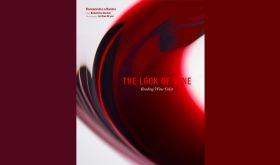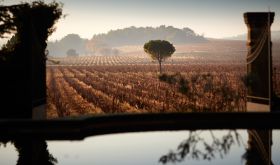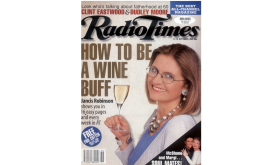SUBJECT TO PHOTOS
It is commonplace in the fine wine market to request digital photographs of cases and bottles before a deal is made. Transactions are 'subject to inspection' or 'subject to photos'. How much one can divine from a photograph of a bottle of wine is another story entirely, as is the bathos of the quality of something as beautiful as, say, a case of Rousseau’s Chambertin being defined by a photo. Though one of the more interesting things about this is the provenance of a wine in terms of its ownership history.
Most wines held in a bonded warehouse carry a sticker detailing the ownership of the case: rotation number, description of wine, and owner (pictures of the wine will have the case in shot too: the lack of an original case will knock 10% off some wines, occasionally more). The schoolboy clanger is to send your picture without having removed the owner’s name first. I’ve seen two of these this year.
An example of an absolute minter would be a case of 2002 Romanée-St-Vivant from Dom Cathiard that, after much effort, sold last month. Bought en primeur from one of the UK’s most prestigious merchants, the cardboard was unmarked, save for the sticker showing its Hampshire destination. A single-owner, pristine case with what a car dealer might describe as 'delivery mileage'. The same goes for anything from the Dom de la Romanée-Conti that still has its bands and has Corney & Barrow branded on the side.
Older cases, and those from Bordeaux in particular, will often have been heavily traded. Some will have stayed in the same warehouse, with just one sticker plastered over the previous one every time the ownership changed. Others will have travelled from, say, Corsham (Octavian) to Tilbury (London City Bond) and back again with a change of ownership, many times in some cases. And, as storage companies start to run out of space and open new sites, this happens more and more often (LCB alone have sites at Tilbury (Essex), Dinton Woods (Wiltshire), Vinothèque (Staffordshire) and more. Some will have crossed continents, though any history of boarding passes will have been erased. I might lose some friends if I expand on this one.
All of which has more to it than a few tips as to spotting whether or not you are being offered a lemon of a case or a pristine one. The end is two-fold: to identify wines that are in bad condition (levels, labels, raised corks, etc) and to identify possible counterfeits (again, another story entirely).
The keener, or more experienced eye, can spot a few more clues. The lightboxes – brightly lit shelves that are used to photograph bottles – can give a wine’s ownership, or at least stewardship, away, as can the stickers on the boxes, and while each warehouse uses the same system of wine identification – what they call rotation numbers – they use different methods of marking each wine, of physically attaching that rotation number to the case. Some look like old supermarket price tags, others are much grander and, rather irritatingly for some, very difficult to remove (this is more than just housekeeping, it’s about hiding the fact that merchant A has bought all the wine that they sold you from merchant B, whom you could have called yourself).
To me this adds to the story of a bottle, and the very best bottles are always about stories, be they from the wine’s conception or about their end.
The best bottle of wine that I have ever drunk was a Berry Bros bottling of 1961 Ch Palmer. It was in pretty poor nick on face value, and had been to Japan at least twice and, in the days before 'subject to photo' it had been rejected twice by the purchaser (not necessarily the same one) and put back on the plane home. Those buyers who rejected the bottle missed something – I got one of the best wine experiences ever when I chose to finally open this bottle with some sausages in front of the telly on a Thursday night.
Why did Mr Smith buy his case of 2002 Romanée-St-Vivant? Had he been spun a very good pitch about an underrated vigneron in Burgundy who was due to be the next big thing (for what it’s worth, Sylvain Cathiard is the only Burgundian vigneron in recent years who has made good on this promise)? Or did he spot a wine that he thought under-priced and therefore a solid speculative buy? Or did he think, like me, that the grand cru vineyards of Vosne-Romanée are a portal through which one can meet one’s maker?
Likewise the heavily stickered and traded cases of 1982 Ch Lafite. Just who was it that paid £300 or so for the case back in 1983 (assuming that the particular case was released en primeur and not later), and why? And why did he (or she) sell it? The same question goes for all owners in between. The question of why someone bought a wine is the easier one to answer – put simply, people like to buy stuff. The question of selling is trickier.
Another, more romantic, piece is somewhere in the pipeline. It’s about the journey that a grape takes from vine to table. Each grape has its own journey, and these can be quite different (for example, a recent bottle of £3.79 Montepulciano and its journey to Lidl in Farnham and then to my mouth versus a bottle of 1983 Clos de la Roche from Dom Dujac and its journey to a table in Hong Kong and again to my mouth) but this journey of trade, and trade only, can be equally fascinating. And I wonder, in the same way that I wonder where some of my more exotic past automobiles have ended up, if the original owners of those heavily stickered cases of claret wonder just where their wine went. I have read about buyers’ regret, but what about sellers’ regret?
HOW TO WRITE A TASTING NOTE, PART ONE
Lunch at Outlaws, the Capital Hotel. Three of us: me, Mr Manners – one of those friends that one meets, these days, through social media – and his friend, again met through Twitter, I think. I brought a bottle of the brilliant Pierrières from Ulysse Collin. Manners brought a bottle of 1985 Ch Latour (any vintage of the Silverback is a treat) and our companion, a Yorkshire academic, brought a very fine 2009 Puligny-Montrachet from Jadot (2009 Jadot whites are rather good; their vinification suits the vintage). The day is made by Sir Roger Moore, who is dining on an adjacent table.
In two or three hours of conversation there is invariably one sentence that matters. On this day it is this: 'what is it with Jancis and her tasting notes?'
Good question. Indeed: what is the point of a tasting note?
What is a tasting note? It is a description of an experience with a wine. Or is it a guide to the consumer’s potential experience with a wine? If the latter, which it undeniably is, then we are spoiled to the point of confusion.
In order to be able to sell a bottle of wine you need to be able to say three things about it. Three descriptive words that will (a) demonstrate your knowledge of said bottle and (b) entice the prospective buyer to transact. The two are associated.
At Nicolas in the late 1990s the price of every bottle in the shop ended with a nine or a five: £3.99 or £3.95, for example. Keen eyes will have noticed that the decimal point between the pounds and pence displayed on the price tag was not always the same shape: some were squares; some were diamonds. This was not accident, nor accountancy. This was code.
Wines ending in a 9 were generally fuller, and more powerful than those ending with a 5. Wines with a diamond-shaped decimal point were more rounded, more supple, than those whose price had a square-shaped decimal point. So even the freshest and most ignorant of salesmen (mea culpa) would have his three points, and one in reserve, about any wine in the shop, without even knowing what it was. Do not underestimate the commercial guile of the French.
Back in 1997, selling £10 bottles of bordeaux, I had never heard of Robert Parker. Any tasting note that expanded into more than one sentence would have been anathema to me. Wine had a simple purpose, one that a long and self-indulgent note would only add unnecessary complexity to. The point was pleasure. Pleasure from the inebriation, and pleasure from the taste.
Seven years later I was tasting the 2003 Bordeaux vintage from barrel. I had done the same with the 2000s though this was my proper initiation – I was expected to work here. That I was with one of the UK’s most experienced and capable tasters – Hew Blair – was both a blessing and a challenge. Here was a man who could teach me everything or simply flick my nonsense opinions away like a fly. He chose to lean toward the former largely, I think, on account of the fact that my driving was half-decent.
Not really knowing what I was doing (from everything to the immediate case in hand to my dress sense – J&B employees do not wear Dr Martens) I chose to write absolutely everything down. Everything. From Hew’s observations on the joys of two partridges with a side by side (a J&B man would never use an over and under) to his complete and concise summary of each wine (Ch Mouton-Rothschild 2003 – a huge block of fruit and a huge block of tannin; if they come together it will be magical).

Great wines do not need long notes. Il y a quelque chose de parfait la dedans sums up 2005 Le Musigny from Dom Mugnier (those are M Mugnier’s words – I still write everything of interest down), as does the last word from my note on Ch Margaux 2005: 'love'. 100 words on a seriously good wine is like a 1,000 word essay on a fifty-word poem: sophistry, and more about proving one’s academic intelligence than an appraisal of the work in hand. Great wines are a million-petalled flower and often beyond description; £5 wines are just that, and need no selling other than a confirmation that they are drinkable. It’s the liquid in the middle that needs the selling and, therefore, the longer pitch.
I am reminded of a different meal a few years back at the brilliant Chez Bruce. I needed some help choosing between, if I remember correctly, the beef or the lamb. I asked our waiter, who replied with an authority and a conviction that was unquestionable: 'the beef, Sir,' writing it down even before I had concurred. No description of either dish. No scores out of 20 or 100. Just a choice made, and the correct choice, as Mr Waiter knew.
Today, for any one wine, we have multiple notes at our fingertips, many of which offer us far, far, more than the three descriptors we need. Blueberries. Crushed rocks (though I do rather like that one). Honey. Lychees (when was the last time you smelled lychees?) And, in the same way that Hew remarked on Ch Pavie 2003 that it 'had the hand of the winemaker all over it', most of the notes that we read from merchants have been written by the hand of the salesman. A little austere? How about classically lifted? A touch tough? How about rugged tannins?
Many of today’s wine writers do the same. No one wants to read negative notes and, as such, much of what one reads is remarkably positive. Is there an agenda here? High scores do tend to get a critic mentioned by those trying to sell the corresponding wines, though I think that it is more to do with what sells papers, if that’s the best way of putting it. Commentary on the 2015 Bordeaux vintage, for example, was overwhelmingly gushy despite the fact that there are more than just a handful of rather dodgy wines. Did everyone taste polished samples, or did some writers take the view that positive notes are what people want to read and that circulation and/or subscription figures might not be the same with less polished prose? This is what my luncheon companion was on about – Jancis’ notes do occasionally finish with the air of an MOT advisory note: 'wiper-blade split' or 'front o/s tyre at legal limit'.
The last 'great' wine I drank was Ch Margaux 1999. It doesn’t need a long note. It tasted of Margaux, of elegance, of class. I probably wouldn’t have nailed the vintage blind, though I would have got the appellation, which is rather the point (especially if your wine shares the name of the appellation) and the sheer quality would have maybe led me to Ch Margaux itself. No advisory notes: if you can afford 1999 Margaux then you will not be disappointed. It does what it says on the tin.















